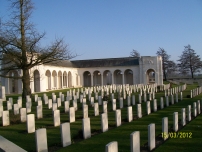| First Name: | James George | Last Name: | BAYLISS | |
|---|---|---|---|---|
| Date of Death: | 10/03/1915 | Lived/Born In: | Borough | |
| Rank: | Rifleman | Unit: | Rifle Brigade2 | |
| Memorial Site: | Le Touret Memorial, France | |||
Current Information:Born-Bermondsey
The Battle of Neuve Chapelle Between 10th and 13th March, 1915, the Indian Army Corps and IV Corps attacked the village of Neuve Chapelle in the Artois region of France. During the winter of 1914-1915, reinforcements had arrived from Britain and this was seen as an opportunity to use them to break through the German lines. It started well. At 7.30am on 10th March, a 30 minute hurricane bombardment destroyed the German wire and front line trenches and at 8.05am the infantry went in. Neuve Chapelle was captured and over a mile of the German line taken. But that was the end of the success. The British chain of command was weak and their communications poor, which was hardly surprising given that many of the troops had no previous experience of battle. The Germans re-organised and reinforced during the night and no further gains were made. British casualties mounted to 12,000 by the time the offensive petered out on 13th March. Leading the attack of 25 Brigade, 8th Division on 10th March were the 2nd Lincolnshire and 2nd Royal Berkshire battalions, attacking on a 400 yard front. They moved across No Man’s Land with little loss and took the German front trench and by 8.20am they had reached the German support line. At 8.35am, the 2nd Rifle Brigade and 1st Royal Irish Rifles battalions started forward. They advanced by companies and almost immediately “C” Company on the right captured over thirty Germans waving a white flag in trenches some 200 yards to the right between themselves and the attack by the Indian Corps. Contact was then made with the Gurkhas in the Neuve Chapelle itself where the German resistance was weak. Scouts and bombers reached the Smith Dorrien Trench which was then occupied and consolidated by “B” Coy whilst others lay out in front covering them Unfortunately this covering party was hit by their own artillery barrage and suffered a number of casualties. A further advance could have been made had 23 Brigade, further to the left, not come to grief on the wire as only a few German reinforcements arrived. Instead 2nd Rifle Brigade were ordered to entrench and along with 1st Royal Irish Rifles they built breastworks from fallen masonry as the ground was too water logged for digging and the Smith Dorrien Trench was uninhabitable. Most of their casualties came during this period of consolidation. At some stage during the day James Bayliss was killed.
|
||||
| « Back to Search Results | ||||
| If you think any of the information shown here is incorrect, Click Here to submit your amends and comments | ||||




